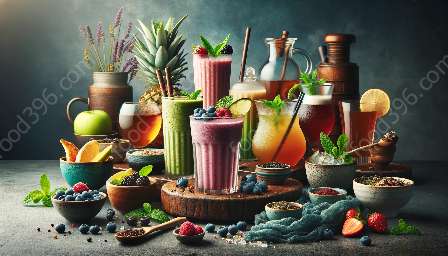Herbal tea has a long history of being cherished for its health benefits, soothing properties, and delightful flavors. In this topic cluster, we will delve into the art of brewing herbal tea, exploring various techniques to infuse flavors, colors, and aromas. We'll discover how to brew herbal tea using different methods and equipment to create delicious and refreshing non-alcoholic beverages that cater to every palate.
Understanding Herbal Tea
To truly appreciate herbal tea, it's essential to understand what it is and how it differs from traditional tea. Herbal tea, also known as tisane, is an infusion made from various plant materials, including flowers, leaves, seeds, roots, or bark. Unlike true teas, such as black, green, white, or oolong, which come from the Camellia sinensis plant, herbal teas are caffeine-free and offer a wide range of flavors and health benefits.
Types of Herbal Tea
Before delving into brewing techniques, it's important to explore the different types of herbal tea available. With a vast array of herbs and botanicals to choose from, herbal teas can be categorized based on their properties and flavors. Some common types of herbal tea include:
- Floral Teas: Herbal blends featuring flowers such as chamomile, lavender, and hibiscus, known for their calming and aromatic qualities.
- Mint Teas: Refreshing and invigorating teas made from peppermint, spearmint, and other mint varieties, offering a cooling sensation.
- Spice-infused Teas: Blends with warming spices like cinnamon, ginger, and cloves, providing a comforting and flavorful experience.
- Root and Bark Teas: Earthy and robust teas crafted from roots and barks, such as licorice, dandelion, and sarsaparilla, known for their grounding properties.
- Fruit Teas: Vibrant and fruity infusions made from dried fruit pieces, including apple, berry, and citrus, offering a sweet and tangy flavor profile.
Brewing Techniques
Now, let's explore the diverse brewing techniques that can be employed to create the perfect herbal tea. Each method brings out unique aspects of the herbs and botanicals, allowing you to customize the flavor, strength, and aroma of your brew. Some of the most popular brewing techniques include:
Infusion Method
The infusion method is a classic way of brewing herbal tea and involves steeping the herbs in hot water to extract their flavors. To achieve the best results, use fresh, high-quality herbs and water at the appropriate temperature. Different herbs require different steeping times, so it's essential to follow specific guidelines to ensure the optimal infusion of flavors.
Decoction Method
For tougher plant materials like roots, bark, or seeds, the decoction method is ideal. This technique involves simmering the herbal ingredients in water on low heat to extract their potent compounds. It's a longer process compared to infusion but is effective in drawing out the herbal essence, resulting in a rich and robust brew.
Cold Brewing
Cold brewing offers a refreshing alternative to hot herbal tea. By steeping herbs in cold water over an extended period, usually 8-12 hours or overnight, the tea acquires a smooth and delicate flavor, free from any bitterness or astringency. Cold brewing is particularly popular for delicate floral and fruit-infused teas.
Steam Infusion
Steam infusion is a sophisticated brewing technique that involves using steam to gently release the essential oils and flavors from the herbs. This method is often utilized in professional settings and requires specialized equipment to ensure precise control over the infusion process, resulting in a nuanced and aromatic herbal tea.
Enhancing Herbal Tea
There are several creative ways to enhance the flavor and visual appeal of herbal teas. Experiment with the following techniques to create captivating and delightful non-alcoholic beverages:
Flavor Infusions
Expand your herbal tea repertoire by infusing additional flavors such as citrus peels, vanilla beans, or spices. These enhancements can elevate the complexity of the brew and introduce new layers of enjoyment.
Artful Presentation
Elevate the drinking experience by serving herbal tea in beautiful glassware or unique teacups, enhancing the visual allure of the beverage. Garnishing with edible flowers, fruit slices, or herbs can also add a touch of elegance.
Creative Blending
Explore the art of blending different herbs and botanicals to create your own signature herbal tea blends. Whether you prefer calming chamomile mixed with zesty citrus or spicy ginger combined with soothing peppermint, the possibilities are endless.
Enjoying Herbal Tea
Once you've mastered the brewing techniques and flavor enhancements, it's time to savor the delightful experience of enjoying herbal tea. Whether for a quiet moment of relaxation, a vibrant social gathering, or as a refreshing beverage with meals, herbal tea offers a versatile and enjoyable non-alcoholic beverage option for everyone to appreciate.

